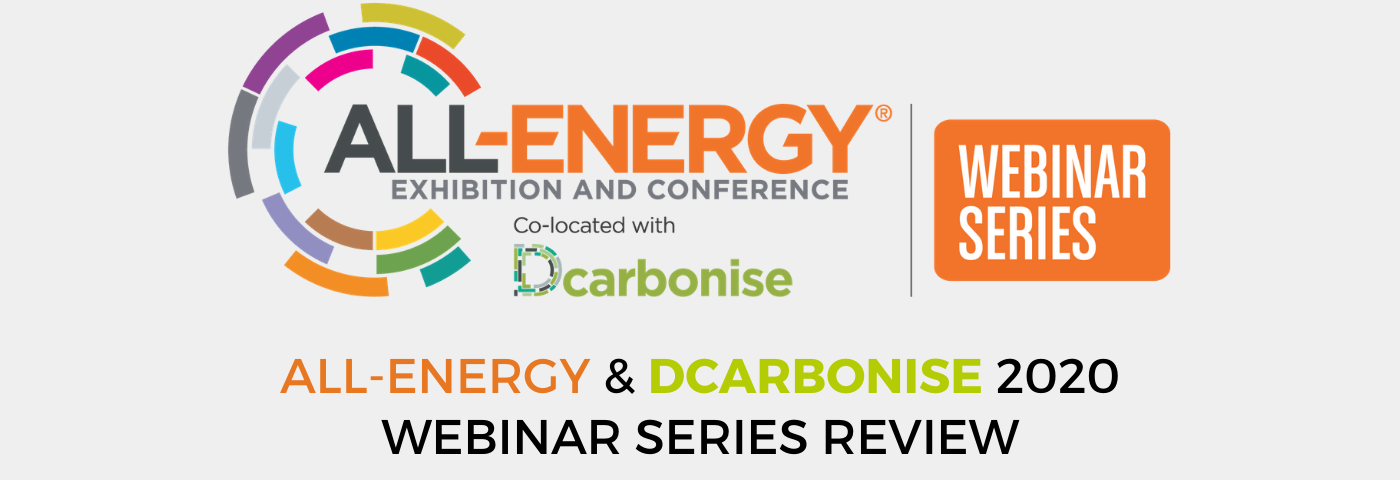All-Energy & Dcarbonise 2020 Webinar Series Review

26 webinars and counting!
Countless Insights on Delivering Net Zero
We created the All-Energy and Dcarbonise webinar series with one thing in mind: supporting the renewable and low carbon energy community during a time of unprecedented challenge. We launched the webinar series with four webinars on what would have been the original dates of the All-Energy & Dcarbonise 2020 event – the 13 and 14 May. We rapidly found the level of support and participation was outstanding.
Capitalising on that success, we now host monthly webinars on the hottest low carbon and renewables topics, including offshore and onshore wind, hydrogen, inclusive transition, community and local energy, solar energy and more. We ramped up the volume in November by holding the All-Energy & Dcarbonise Virtual Summit, which comprised eight webinars over three days, with stellar speakers including Rt Hon Nicola Sturgeon MSP and Paul Wheelhouse MSP.
Click below to view the full series overview and tune in to our sessions on-demand.
Offshore wind: Keeping our eye on the long term prize

Speakers

Director, Lumen Energy & Environment
Maf Smith is the founding director of specialist consultancy Lumen Energy & Environment. He is an expert in energy transition, with a 20+ year leadership career in the renewable sector.
Between 2012 and 2019 Maf was the Deputy CEO of RenewableUK. In this time he was chief spokesperson, represented industry at all levels of Government, and managed the Association’s membership and commercial growth. Prior to this Maf worked in DECC on Electricity Market Reform, was Director of Scotland for the Sustainable Development Commission between 2006 and 2011, and CEO of Scottish Renewables between 2002 and 2006.

Managing Director, Iberdrola Global Offshore Wind Business
Jonathan is based in the UK and runs the Offshore Wind Business of Iberdrola Renewables (ScottishPower Renewables in the UK).
Under Jonathan’s leadership, Iberdrola’s Offshore Wind Business has grown from its inception in 2011 to a business with €6Bn under investment and more than 300 professional staff.
Jonathan is responsible for the development, construction and operation of a large international pipeline of projects, including 3,500MW of Projects off the East Anglian coast, >1,000MW of projects in Germany, 500MW in France and >5,000MW in the US.
Jonathan also sits as Chairman/Director of a number of industry bodies, including the UK Government’s Offshore Wind Programme Board, the Global Offshore Wind Health & Safety Organisation and the Offshore Renewable Energy Catapult’s Industry Advisory Group.

Senior Specialist, Strategy, Business Development and Government Relations, MHI Vestas Offshore Wind
Mary leads MHI Vestas’ Government Relations and policy team, ensuring policy frameworks and the political environment work together to deliver sustainable, long term growth in offshore wind markets around the world. Mary joined MHI Vestas from Vattenfall, the state-owned Swedish utility and one of the world’s largest offshore wind developers. Mary has strong experience of the UK CfD and wider offshore wind space as it has evolved and grown, working with Government and wider stakeholders to ensure offshore wind delivers low cost power to UK businesses and communities. Mary also played a key role with the UK industry and Government in delivering the Offshore Wind Sector Deal

Benj is Head of Market Development, Consenting and Public Affairs in the UK offshore wind business of Ørsted and is responsible for business growth, setting and delivering the company’s sustainability and environmental agendas, and managing Ørsted’s relationships across government, authorities and NGOs.
He is Chair of the Offshore Wind Industry Council and led the work to agree a Sector Deal with Government; he also serves on the Board of G+, providing Health and Safety leadership for the offshore wind sector. He is a member of the government-appointed Advisory Panel on Highly Protected Marine Areas.
Benj previously worked in the upstream oil and gas industry.

Environment Division Manager, Xodus Group
As Environment Manager at Xodus Group, Christina Horspool is a proactive, innovative and inspiring business leader in the areas of climate change, energy efficiency, decarbonisation and sustainability. Christina’s experience across the energy sector, including offshore wind and oil and gas, as well as her technical background in atmospheric emissions, carbon accounting and carbon lifecycle, allows her to lead the 60-strong team of environmental and marine specialists across the UK.
The Xodus vision is that ‘together, we will deliver a responsible energy future’. Christina is proactively reinforcing the company vision through her engagement across industry including various Oil and Gas UK forums around decarbonisation and energy transition; and through the Scottish Government-backed Future Industry Leaders Programme. Christina’s proactive approach to people development and innovation across the energy sector, as well as her underlying objective for sustainability and efficiency, has paved the way for a well-motivated, engaged, multi-skilled team of consultants all working to deliver clean energy alongside sustainable economic growth. Most recently, Christina has been a core part of Xodus Group’s aim to help the UK energy sector deliver beyond its net zero ambitions through innovative technologies, processes and techniques.
Christina sees offshore wind as a critical part of the UK’s response to climate change and is passionate about leveraging the cross-sector opportunities offered through the UK’s long track record in offshore energy and infrastructure projects; whether these be associated with offshore wind helping to decarbonise oil and gas activity, or helping supply chain or the workforce prepare for the next phase of major growth in offshore wind.
If you need any further information do give me a shout. My mobile is on my signature so feel free to give me a call on there.

Senior Business Development Manager, National Grid Ventures
Morris is a Senior Business Development Manager for National Grid Ventures, leading new HVDC developments between GB and other countries in the North Sea region. He has experience of HVDC interconnector project development, having led National Grid’s team in the development phase of the IFA2 interconnector between GB and France along with RTE, and advocates the transition to a North Sea grid through multi-purpose interconnectors that combine the benefits of connecting markets with benefits of providing offshore connections for offshore wind. Morris is a member of the European Commission Expert Group on Interconnection Targets.
Call for Speakers for show floor theatres now open

Seven months from today (13 October) the 25th anniversary edition of All-Energy, the UK’s largest renewable and low carbon energy exhibition and conference, will open. Being held by RX at Glasgow’s Scottish Events Campus (SEC) on 13 and 14 May 2026, it is already on track to be the biggest edition ever. Bookings are 42% ahead year on year and for the first time there will be over 300 main stand holders, with that number swelling, thanks to stand sharers.
The 2025 edition of All-Energy attracted total attendance of 13,033 and an 11% increase in total unique visitors year-on-year: some 300+ exhibitors (including stand sharers) and 600 speakers. The 2026 event is set to bring together industry leaders, innovators, policymakers and investors from home and overseas.
Call for Speakers now open
The Call for Speakers is now open for the event’s seven show floor theatres in which the spotlight turns on cutting-edge technology, innovation, and practical solutions driving the renewable and low carbon energy future. Positioned at the heart of the exhibition, they provide an ideal platform to share knowledge, showcase expertise, and spark collaboration across the full energy supply chain.
The seven theatres featured this year are:
- Innovation Theatre
- Future Talent Theatre
- Offshore and Onshore Wind Theatre
- Future Grid Theatre
- Hydrogen Theatre
- Built Environment and Community Theatre
- Solar and Storage Theatre
Further information on them is at https://www.all-energy.co.uk/en-gb/conference/call-for-papers.html. Formats can include presentations, panel discussions, fireside chats and keynotes. The emphasis will be on lessons learned and case studies that highlight successful implementation and innovative practices. Speakers’ expertise can inspire others and foster collaboration across the sector.
Abstract submission is easy. There is a simple online form and multiple submissions across different themes are welcomed. The deadline for submissions is 23 January 2026.
Looking forward to the All-Energy Strategic Summit
“We’re expecting a fantastic response to the Call for Papers for our show floor theatres. While there isn’t a Call for the All-Energy Strategic Summit, we’re already in discussions with key stakeholders who will form our Executive Board. Together, we’ll be shaping the Summit’s themes and panel discussions, drawing inspiration from the UK Government’s Clean Energy Industries Plan and focusing on frontier sectors that will be highly relevant next May.
“The full Strategic Summit programme, along with details of our side events and a first look at our special 25th Anniversary features, will be unveiled in January 2026.
“We’re also thrilled by the outstanding response from exhibitors so far. To be 42% ahead at this stage is a first for All-Energy and reflects the event’s growing momentum as the UK’s meeting place for the entire clean energy community. It’s clear that the industry’s enthusiasm for collaboration and innovation continues to grow as we look toward our 25th anniversary edition next year.
“All-Energy’s success also benefits from being part of RX’s global portfolio of leading energy events, including Oceanology International, SPE Offshore Europe, the World Future Energy Summit, and the World Hydrogen Summit & Exhibition (with associated events in the USA, Australia, and Saudi Arabia). Our sister event, All-Energy Australia, opens later this month in Melbourne, continuing to build international connections and insight across the sector.. A full list appears at https://www.all-energy.co.uk/en-gb/about/energy-marine-events.html.”
Further details on all aspects of All-Energy, from the ever-growing exhibitor list and information on exhibiting and sponsorship to the Call for Speakers is at https://www.all-energy.co.uk/PR.
All-Energy 2025 breaks last year’s record

Total attendance of more than 13,000 over two days makes All-Energy 2025 a record breaker. The UK’s largest renewable end low carbon energy exhibition and conference, owned and organised by RX, was held 14-15 May at Glasgow’s SEC. Last year’s corresponding figure was 11,736.
The increase in attendance was reflected by packed aisles, conference halls, show floor theatres and academic posters (between them they boasted nearly 600 speakers during the two days) and smiles and congratulations in plenty from over 300 exhibiting organisations, many of whom have already re-booked for next year’s silver anniversary event being held at SEC on 13 and 14 May.
“All-Energy 2025 has been our most ambitious and inspiring edition yet,” said Event Manager, Anam Khan. “For the first time, we expanded into SEC’s Hall 3, reflecting the incredible growth of the event, and even with the additional space, the aisles were packed and buzzing with energy from start to finish. From record-breaking attendance to powerful discussions on the future of clean energy, it’s clear that the appetite for innovation and collaboration in the sector has never been stronger.
“We’re incredibly proud to provide a platform that brings together industry leaders, game-changing innovators, policymakers, and the next generation of talent; all under one roof in Glasgow. This event is a testament to what we can achieve when we work together to drive the energy transition forward and engineer a net-zero future.
“Our exhibitors came from all over the UK and Northern Ireland, and also from Canada, China, the Czech Republic, Denmark, France, Finland, Germany, Italy, Ireland, Netherlands, Poland, Portugal, Spain, Sweden, Switzerland, Taiwan. They included many of the big names such as ScottishPower, SSEN Transmission, Hitachi Energy UK, Vattenfall, Statkraft, RWE Generation, Innovate UK and ABB.”.
Packed conference halls, rooms and show floor theatres was very much the order of the day. The programme comprised compelling plenary sessions at the start of each day, and a further 54 sessions on all forms of renewable energy; on decarbonisation of heat, transport, cities/places, and industry; and ‘vital ingredients’ such as the expansion of the grid, hydrogen, energy storage, skills and training, recruitment, investment, PPAs, local energy ED&I, and mental health in the main conference. The seven show floor theatres saw an illuminating mix of presentations and panel discussions; and academic posters provided food for thought and discussion.
On opening morning, the Lomond Auditorium was packed to hear the Deputy First Minister of Scotland, Kate Forbes MSP, give a keynote address. The timing coincided with legislation to establish the publicly owned Great British Energy company formally passing through the UK parliament, meaning Michael Shanks MP, the UK’s Energy Minister, had to remain in London so he filmed a video of his inspiring keynote speech, Professor Sir Jim Skea, Chair of the IPCC also provided a thought-provoking video – both are now on the All-Energy website.
Keith Anderson, CEO of ScottishPower chaired the session which included a panel - Juergen Maier, Chair of Great British Energy, Councillor Susan Aitken, The Leader of Glasgow City Council; Andrew Lever, Director - Energy Transition at the Carbon Trust and Adrian Gillespie CEO of Scottish Enterprise. Over 620 were in the hall to hear the session with a further 275 in the overflow room..
The Lomond Auditorium was packed again the following day when Professor Sir Jim McDonald, Principal and Vice Chancellor of Strathclyde University chaired the session with a keynoter address by Chris Stark CBE, Head of Mission Control for Clean Power 2030, Department for Energy Security and Net Zero , followed by a panel discussion featuring Professor Keith Bell, ScottishPower Chair in Smart Grid; Tom Glover, UK Country Chair, RWE; Dhara Vyas, Chief Executive, Energy UK; Rachel Fletcher, Group Director of Regulation and Economics, Octopus Energy; and Darren Davidson, Vice President UK & Ireland, Siemens Energy.
Anam Khan explained: “Networking is key to All-Energy and the Giant Networking Evening, that has been held at the Glasgow Science Centre since the show moved from Aberdeen in 2015, provides a relaxed venue at which the conversations started on stands or as the result of conference sessions can be caried on as well as providing a chance for meeting up with old friends and making new acquaintances. We are grateful to the Rt Hon the Lord Provost of Glasgow for the Civic Reception which is an integral part of an evening that continues to play an important aspect of All-Energy.
She added: “Naturally I would like to thank exhibitors, speakers, chairs and sponsors for their commitment to the show; and the visitors who came in their thousands, and our sponsors. All-Energy’s headline sponsor, Shepherd and Wedderburn, celebrated its 11th year in the role; other sponsors included Noventa, Hitachi Energy UK, Statkraft, SEFC, Black & Veatch, SGS, Flexitricity, AMSC, XING Mobility Inc and the University of Sheffield. Glasgow Convention Bureau is All-Energy’s official partner; and The Society for Underwater Technology which has been its Learned Society Patron since the very first event. All combine to make this year’s show, set right in the middle of Glasgow’s Climate Week, and during Glasgow’s 850 year celebrations, a very special two days.
All-Energy 2026 will be held 13 and 14 May at Glasgow’s SEC. Further information is available from www.all-energy.co.uk
All-Energy 2025: Grid expansion very much in focus

Only SIX days to go!
Both Scottish Transmission Operators (TOs) Scottish & Southern Electricity Networks (SSEN) Transmission and SP Energy Networks are heavily committed to upgrading the power grid and exhibiting at All-Energy (SEC Glasgow – 14-15 May) along with key suppliers such as Hitachi Energ UK and Schnider Electric UK.
Announcements from them come thick and fast. Today (8 May) The National Wealth Fund (NWF) has announced a £600m commitment to help Iberdrola and ScottishPower upgrade the British electricity grid – supporting hundreds of jobs and helping to pave the way for a new era of clean electricity. Only last month SSEN Distribution announced that it is to invest almost half a billion pounds improving the north of Scotland’s local electricity networks, an investment that will make the existing network more resilient and provide additional capacity to support the decarbonisation of communities and industry..
With grid expansion a key conference topic, there is a specially built large theatre (Conference Stage 1) in Hall 3 at SEC to house five of the seven conference session devoted to grid. This is in addition to the FutureGrid show floor theatre programme. Which will be in operation throughout the two days of the UK’s largest renewable end low carbo energy exhibition and conference.
Registration is at https://www.all-energy.co.uk/PR and is free for all with relevant business or academic interests. Once registered, visitors can take advantage of the All-Energy App, which is ready to download and use. It can be used to browse the full exhibitor directory (over 300 organisations from 17 countries will be taking part) using filters to find the companies involved with grid and networks listed, and all main conference and show floor theatre programmes, special features and networking facilities. These networking facilities can be used to browse profiles, send messages and request meetings as well as checking the ‘What’s On’ facility for a variety of events and opportunities..
The first grid session in the main conference ‘Where is the UK on its energy transition journey? And how is Grid helping or hindering?’ will set the scene and is chaired by Professor Keith Bell, ScottishPower Chair in Smart Grids.
His explanatory introduction to the 90-minute session explains: “Everything is in place for clean energy: there is plenty of low carbon generation and storage in the connection queue and strong appetite from investors; there are government commitments to reform planning and place ample new contracts for difference; there has been lots of innovation; and there are well-advanced plans for transmission network development.
“Or: only a portion of the grid connection queue can be expected to be advanced and the ‘stickability’ of queue reforms is yet to be tested; constraint costs are large and growing; we keep changing our minds on what a holistic network design looks like; Britain’s network companies have been slow out of the blocks in striking contracts for equipment and hiring and training personnel; wholesale market reform raises big uncertainties; there are questions about resilience; and we haven’t even started thinking about how to accommodate increased demand for power. Which of these narratives is true? Join this panel of experts to find out.”
He certainly has experts on his panel - Rob McDonald, Managing Director SSEN Transmission; Nicola Connelly, CEO, SP Energy Networks; Julian Lesley, Director of Strategi Energy Planning and Chief Engineer at the National Energy System Operator (NESO); Melanie Macrae, Deputy Director Clean Power 2030 Unit, Policy and Delivery at the Department for Energy Security and Net Zerio (DESNZ); Tom Hughes, Assistant Director energy, National Infrastructure and Service Transformation Authority. The quality of the line-up is reflected in all the sessions in the grid and network stream.
Other sessions look at ‘The complexity of the grid upgrade: the Net Zero grid must be smarter as well as higher capacity‘ sponsored by Hitachi Energy UK with Laura Fleming, Country Managing Director for Hitachi Energy in the UK and Ireland delivering a key note address and then joining the panel of experts from National Grid, Innovate UK, Grid Enhancing Technologies, and NESO with Susan McDonald, Energy Transition Lead, Deloitte in the chair
Next come sessions on two vital topics – connections, and REMA . Both have been discussed before at All-Energy in 2023 and 2034. The first (on 14 May) is ‘Connections Strategy and Reform: Aligning with Clean Power 2030’ with Lawrence Slade, CEO of the Energy Networks Association once again in the chair.; and the second, with Kersti Berge, Director of Energy and Climate Change, Scottish Government in the chair for the third year running is ‘Review of Electricity Market Arrangements (REMA): An update’ (on 15th).
Other grid-related sessions are an Innovate UK, SIF, Ofgem ‘Consortium building workshop for Ofgem SIF Roud 5; and ‘Marketing the Transition’. Session descriptions and full speaker lists are online at https://www.all-energy.co.uk/25 and on the All-Energy 2025 App.
All-Energy’s headline sponsor, Shepherd and Wedderburn, celebrates its 11th year in the role; other sponsors include Noventa, Hitachi Energy UK, Statkraft, SEFC, Black & Veatch, SGS, Flexitricity, AMSC, XING Mobility Inc and the University of Sheffield. Glasgow Convention Bureau is All-Energy’s official partner; and The Society for Underwater Technology is its Learned Society Patron. All combine to make this year’s show, set right in the middle of Glasgow’s Climate Week, and during Glasgow’s 850 year celebrations, a very special two days.
All-Energy 2025: A feast of offshore wind learning on offer!

The UK government’s Clean Power 2030 mission lies at the heart of the UK’s largest renewable and low carbon energy exhibition and conference – All-Energy 2025, owned and organised by RX. Being held at Glasgow’s SEC on 14 and 15 May it is free to attend for all with relevant business or academic interests. Offshore wind conference sessions and show floor presentations run through the two days like words through a stick of seaside rock.
Following compelling opening plenary sessions on both days the first featuring political keynotes addresses from the Deputy First Minister of Scotland, Kate Forbes MSP and the UK’s Energy Minister, Michael Shanks MP’ and the second, Chris Stark CBE, the Head of UK’s Mission for Clean Power, Department for Energy Security and Net Zero, All-Energy’s conference divides into 11 parallel sessions and seven show floor theatres
There are six 90-minute offshore wind sessions in the main conference plus a lunchtime ‘fireside chat’ on Thursday 15 May involving Tim Pick MBE, Commissioner, Clean Power 2030 Advisory Commission; and Chair, Offshore Wind Growth Partnership; and a compelling two-day show floor theatre programme.
Registration is at https://www.all-energy.co.uk/PR and is free for all with relevant business or academic interests. Once registered, visitors can take advantage of the All-Energy App, which is ready to download and use. It can be used to browse the full exhibitor directory (over 300 organisations from 17 countries will be taking part), and all main conference and show floor theatre programmes, special features and networking facilities. These networking facilities can be used to browse profiles, send messages and request meetings as well as checking the ‘What’s On’ facility for a variety of events, including the Giant Networking Evening – incorporating the Civic Reception.
Offshore wind well covered
All-Energy’s Headline Sponsor, Shepherd and Wedderburn creates two sessions for the offshore wind conference stream. The first looks at ‘Offshore Wind 2024: A Year in Turmoil – How do we get back on track?’ discussing the challenges the industry has faced in the last 12 months and at some of the global issues including politics and confidence in the supply chain.
Chaired by Shepherd and Wedderburn’s Colin Innes, the panellists - Charlie Jordan, CEO, ScottishPower Renewables; Claire Mack co-Chair of the Scottish Offshore Wind Energy Council (SOWEC) and Chief Executive of Scottish Renewables; Jonathan Cole, Chair of GWEC; Isla Robb, Director of Offshore Renewables at the Energy Transition Zone, and Una Brosnan of - will consider how the industry can get back on track and deliver for the UK.
Attention then moves to ports in ’Are we there yet? The long port infrastructure journey’ with National Wealth Fund’s Colin Hudson; Global Energy Group’s Iain Sinclair; Gillian Morrison from Crown Estate Scotland; Lewis Gillies of Haventus; and Susie Lind of BlueFloat Energy | Nadara Partnership and Shepherd and Wedderburn’s Clare Foster in the Chair
Other sessions look at ‘Floating wind – a strategic opportunity for the UK’s clean power future’ devised by Flotation and chaired by its Chief Executive, Lord Nicol Stephen; and ‘Powering Safety: Energise your Workforce with the next Evolution in Safety’ held in association with IMCA with Lisbeth Norup Frømling, Senior Vice President QHSE Ørsted and Chair of G+, amongst the speakers. The final offshore wind session in the Lomond Auditoirum is ‘Harnessing Ocean Renewable Energy: Technology solutions for a resilient green hydrogen local supply chain’ with Myrtle Dawes, CEO, Net Zero Technology Centre chairing and .
The Marine and Offshore Wind Directorates of the Scottish Government combine resources to produce a packed 90-minute session (on 14 May) chaired by Zoe Crutchfield, Head of the Marine Directorate Licensing Operations Team, devoted to ‘Working together to deliver Net Zero’. This involves 10 speakers looking at the National Marine Plan 2, the Sectoral Marine Plan, the Strategic Compensation and Marine Recovery Fund; and the Scottish Marine Energy Research (ScotMER) Programme update. An update from operations (offshore wind, wave and tide, ports and harbours) follows; and the session draws to a close with a panel comprising three Scottish Government Marine and Offshore Wind Deputy Directors.
The show floor theatre programme spotlights case histories, technology and innovations. On 15 May a whole morning in the Wind Theatre (which looks at both on- and offshore challenges and opportunities) sees The Society for Underwater Technology (All-Energy’s Learned Society Patron) and the Offshore Renewable Energy Catapult stage an introduction to key topics in offshore systems, focusing on the requirements, analysis methods and dependencies of moorings and cables. In a dozen bite sized chunks, it delves into the critical considerations for designing and implementing these systems, followed by discussions on the latest technologies and emerging solutions that are shaping the future of mooring systems and their components.
Presentation on Floating Offshore Wind (FLOW )also feature in the Marine renewables and FLOW theatre. Full programmes are available online at https://www.all-energy.co.uk/25 and on the All-Energy 2025 App.
All-Energy’s headline sponsor, Shepherd and Wedderburn, celebrates its 11th year in the role; other sponsors include Noventa, Hitachi Energy UK, Statkraft, SEFC, Black & Veatch, SGS, Flexitricity, AMSC, XING Mobility Inc and the University of Sheffield. Glasgow Convention Bureau is All-Energy’s official partner; and The Society for Underwater Technology is its Learned Society Patron. All combine to make this year’s show, set right in the middle of Glasgow’s Climate Week, and during Glasgow’s 850 year celebrations, a very special two days.
Heat decarbonisation in the spotlight at All-Energy 2025

Heating and cooling contribute a large share of global energy-related carbon dioxide emissions, therefore a "just transition" in the context of heat decarbonization aims to ensure that the shift to low-carbon heating systems benefits everyone and doesn't disproportionately burden vulnerable populations or industries. This year there are more heat sessions in the main conference at All-Energy, the UK’s largest renewable and low carbon energy exhibition and conference (SEC Glasgow 14-15 May) than ever before – one with a political keynote address from Scotland’s Acting Climate Action Minister.
Registration is at https://www.all-energy.co.uk/PR and is free for all with relevant business or academic interests. Once registered, visitors can take advantage of the All-Energy App, which is ready to download and use. It can be used to browse the full exhibitor directory (over 300 organisations from 17 countries will be taking part), and all main conference and show floor theatre programmes, special features and networking facilities. These networking facilities can be used to browse profiles, send messages and request meetings as well as checking the ‘What’s On’ facility for a variety of events and opportunities.
The first heat session in the main conference on 14 May, looks at ‘Scotland’s Heat Transition’ explaining that: “Our homes and workplaces account for around a fifth of Scotland’s total greenhouse gas emissions, and eliminating these by 2045 will be immensely challenging. This session brings together speakers from across sectors to discuss how we can decarbonise heat from Scotland’s buildings, so they are warmer, greener and more efficient. “
There will be a Ministerial address by Scotland’s Acting Minister for Climate Action Dr Alasdair Allan MSP; then, chaired by Jennifer Arran, Head of Residential Energy at LCP Delta a panel comprised of Kerry Alexander, Director – Infrastructure Finance and Programmes from the Scottish Futures Trust; Robin Parker, Mission Manager (A Sustainable Future), from Nesta Scotland Rob McGaughey, Head of Smart Cities and Heating at ScottishPower and Andrew Kubski, Director of Property Services, River Clyde Homes will share their views and discuss key points and the answers to audience questions.
Next on the agenda is ‘A Heat Network in Every Scottish City - Vision to Reality’ which takes the view that Scotland needs to urgently change how it heats its cities and towns to meet the Scottish Government’s target of decarbonising heat by 2045.
In November 2024, Scottish Renewables (who created the session) published their report National Heat Networks: A Vision for Scotland, setting out the key actions needed from the Scottish and UK Governments to establish city-wide heat networks across Scotland. “In this session, you will hear from policymakers and stakeholders shaping the future of heat networks about how we can turn this vision into reality”, they explain. Morag Watson of Scottish Renewables will chair the discussion which sees Paul Steen, Head of Business Development at Vattenfall, Iain Ward, Director EHeat Networks, at ScottishPower and James Hemphill, Head of Heat Networks Policy Unit in the Scottish Government taking part and looking forward to questions from the audience.
The third session in the stream is devoted to ‘Geothermal – Ready to bridge the renewables gap’. Edinburgh-based geothermal consultancy TownRock explain: “Geothermal energy is gaining global traction as a renewable energy source that has cross-party support. Technology and project developers, especially in the USA and China, as well as Germany and other European countries, are racing ahead by raising vast sums of investment and receiving helpful policy support.
“In the UK things are slowly gaining momentum, especially for heat production, but also with the UK’s first geothermal power plant coming online in Cornwall where geothermal waters are also rich in lithium. In this session, we have brought together leaders from business and public sector to share expertise across this exciting and growing area of work, to show how geothermal is ready to deploy now to bridge the renewable energy gap.”
The final heat session in the main conference ‘Manufacturing Opportunities in Clean Heat and Retrofit’, held in association with Scottish Enterprise, NMIS, PNDC, SMAS, and key manufacturers Mitsubishi and Star Refrigeration involving eight speakers chaired by Doreen Reid, Team Leader, Scottish Enterprise, comes with an invitation to “Join this Team Scotland event to explore exciting new manufacturing opportunities in the rapidly growing clean heat sector.”
“Decarbonising heat presents a multi-billion-pound market for Scotland, and this event will show you how to capitalise on it. Learn about the specific components needed for heat pumps, heat networks, energy-efficient buildings and associated technologies, and discover how to leverage your existing skills to enter this growing market. This will be a rare opportunity to listen to manufacturers and network with all the support available in the one room.”
That’s not where the learning opportunities end, far from it. The Dcarbonise show floor theatre programme features nearly 20 dedicated heat presentations during the course of the two days.
All-Energy’s headline sponsor, Shepherd and Wedderburn, celebrates its 11th year in the role; other sponsors include Noventa, Hitachi Energy UK, Statkraft, SEFC, Black & Veatch, SGS, Flexitricity, AMSC, XING Mobility Inc and the University of Sheffield. Glasgow Convention Bureau is All-Energy’s official partner; and The Society for Underwater Technology is its Learned Society Patron. All combine to make this year’s show, set right in the middle of Glasgow’s Climate Week, and during Glasgow’s 850 year celebrations, a very special two days.
Meet the All-Energy 2025 Ambassadors: Lesley McNeil, Muirhall Energy

The UK’s leading clean energy event returns to the SEC this May for two days of networking, connections, and uninterrupted business with the renewable energy community.
Last year’s event was packed with unmissable events with a total attendance of 11,763 visitors, 600 speakers and 270 exhibitors.
Focusing on a Net Zero future
This year, the focus is on engineering a Net Zero future.
Developers, investors and buyers are coming to the conference to discover the latest trends and solutions. You’ll be able to meet with representatives and colleagues in the industry management, sales or procurement.
The event in Glasgow will also see buyers from sectors such as local government authorities, consultancy services, power suppliers, software developers, OEMs, and education, hoping to check out the next big thing in renewable energy solutions.
All-Energy helps to connect your technology and solutions to the UK renewable energy industry to better engineer an integrated Net Zero energy future.
Introducing Lesley McNeil, All-Energy Ambassador
At All-Energy, we’re proud to collaborate with a group of expert Ambassadors representing five key sectors driving the energy transition: Offshore Wind, Onshore Wind, Grid & Networks, Hydrogen, and Decarbonisation & Sustainability.
These Ambassadors act as advocates for the events, bringing invaluable insights and ideas from their areas of expertise to help shape the direction of the conference. They’re actively involved in developing content, contributing to conference sessions, and helping us spotlight the issues, innovations, and opportunities that matter most.
From editorial features and articles to on-stage discussions, our Ambassadors are at the heart of our mission—to drive meaningful dialogue and progress across the industry. – Tina Abulashvili, All-Energy event organiser, Product Marketing Manager.
Lesley McNeil’s professional background is nothing short of impressive. After serving 14 years in the Scottish Government as Head of Onshore Wind Policy and Development, Lesley also has previous experience in the determination of large-scale electricity applications with roles in the Energy Consents Unit.
Three years ago, Lesley transitioned from the civil service to the private sector and joined Muirhall Energy as the Head of External and Corporate Affairs.
This year, Lesley is excited to attend the conference as an All-Energy Ambassador. She said: “I am excited and delighted to be attending the All-Energy conference in Glasgow as an Ambassador for Onshore Wind. I’ve been to every All-Energy event for at least the last decade, speaking on various panels so this is like coming home. My real passion and focus has always been Onshore Wind, so I’m excited to speak about how this is the cheapest and fastest deployed technology. We’re saving the world!”
Lesley is looking forward to connecting and learning more from her colleagues in the industry, saying: “This will be the first year that I’m not actually speaking or moderating. I’m looking forward to attending other events and talks and really take in the atmosphere.
“I’ve been working on tech barriers to onshore wind for some time, so I’m looking forward to Technical Barriers to Wind Development: Unlocking Opportunities in the UK which will be chaired by Heidi Douglas-Osborn from Renewable UK with the wonderful Temeeka Dawson, Anne Stevenson, Megan Amundson and Jim Wylie speaking on aviation and eskdalemuir issues.
Lesley is also keen to highlight Muirhall’s recent work in onshore wind in the drive to net zero. She said: “Lately, the most interesting thing Muirhall is doing is looking at community benefits through a different prism. We have been committed to delivering community benefits for a long time, putting money into areas that have been more rural and deprived of investment, which is a good thing. But now we are looking at it through the angle of ‘how can we direct these funds while making it useful?’ After all, it’s only a just transition to net zero if everyone can feel the benefits of that.”
She continued to describe Muirhall’s work with energy discount schemes, saying: “These schemes are fantastic, and we are asked about them every time we go into communities, but we really want to extend the help to families that are in fuel poverty or suffering from deprivation.
“The community benefit funds are growing exponentially as wind farms grow, so we’ve gone beyond the point of small investments, which are normally aesthetic, and into legacy life-changing community money.
“And so, we have to ask: how do we make that switch up in thought, and how do we really use this for the betterment of everyone? How can we use this to capitalise on shared ownership? And finally, how do we make it better for the industry and for the community as well?”
Lesley will be at the conference to speak about these questions and more while representing Muirhall Energy.
She said: “I’d love to catch up with colleagues old and new at the event, please feel free to get in touch or just drop by and see me at stand J11”
Learn more about All-Energy Conference 2025 and register to attend today.
Dr. Kerry-Ann Adamson-Morland is championing innovation and connection at All-Energy 2025

When it comes to shaping the future of hydrogen and low-carbon energy, few voices carry more weight than Dr. Kerry-Ann Adamson-Morland. With over 25 years of industry experience, she’s a globally respected innovator, intrapreneur, and entrepreneur whose work has spanned the entire hydrogen value chain.
Now, in her role as Global Head of Hydrogen at Capgemini, she brings that expertise to one of the world’s largest organisations focused on digital transformation and sustainability. This year, she’s also proudly stepping into the spotlight as an ambassador for the All-Energy Conference 2025.
“I’m an unashamed fan of All-Energy,” she says enthusiastically. “I think it is the best energy event in the UK—and the fact that it’s free is phenomenal.”
A global career rooted in hydrogen
Dr. Adamson-Morland’s journey through the hydrogen and fuel cell sector has been anything but conventional. “I’ve been in low-carbon hydrogen and fuel cells for 26 years,” she explains. “And I’ve always stuck with it because there’s so much we need to do.”
Her career has seen her operate at the leading edge of innovation, with roles in Germany at the Technical University of Berlin under a Marie Curie Fellowship. She’s founded her own advisory company and worked as both an intrapreneur and entrepreneur—experiences that now empower her to bridge gaps between large corporates and agile innovators.
“I’ve always worked at the front end of this industry,” she says. “Not as an engineer, but with a 360-degree approach—policy, regulation, economics, safety, investment, digital… Every job brought a new angle and new learning.”
That comprehensive vision is what she now brings to Capgemini. “It’s only really now that I can bring all of that to bear in one place and say, ‘Right—we’re going to bring our A-game to this sector.’”
Being named an All-Energy Ambassador is something Kerry-Ann doesn’t take lightly. “When I got asked, it was a really proud moment,” she says. “It’s a badge of honour for me. Honestly, I take it as a big compliment from the organisers.”
So what does the role involve? For Kerry-Ann, it’s all about shining a light on the incredible talent and expertise that the event attracts. “It’s a free event with some incredibly talented people. There’s no other forum I know of where you can access that level of talent and seniority in the UK so easily.”
As someone who understands both sides of the energy conversation—from start-ups to multinational firms—Kerry-Ann is uniquely positioned to advocate for meaningful dialogue and collaboration. “Being able to have that joined-up conversation… it enables things to move quicker,” she says. “You know what someone’s talking about, and you can say, ‘Here’s what we can do, and here’s what we can’t.’”
Looking forward to All-Energy 2025
This year, she’s particularly excited about a new panel on digital innovation in the energy sector—something she sees as vital to the industry’s growth. “Energy systems are still immature when it comes to digital,” she says. “People throw around buzzwords like AI or digital twins, but how many of us are embedding that in day-to-day business?”
The new digital panel is a step in the right direction, offering accessible conversations about the practical applications of emerging technologies. “It’s about real use cases. Real action items.”
In fact, Kerry-Ann believes this actionable insight is what sets All-Energy apart. “Most of the speakers hand out two or three tangible takeaways, whether they realise it or not. There’s a lot of free business advice if you’re listening.”
With hybrid working and digital transformation reshaping how we connect, Kerry-Ann sees All-Energy as more than just a conference—it’s an anchor point in the professional calendar. “It’s a fixed point in time and space,” she says. “A chance to say, ‘I’ll meet you there.’ To reconnect, to collaborate, and to create new possibilities.”
Whether you’re a seasoned expert or a newcomer to the energy transition, Dr. Kerry-Ann Adamson-Morland believes All-Energy is a door that’s wide open—and one that’s well worth walking through.
“Honestly,” she says with a smile, “they do all the hard work. All you have to do is show up.”
All Energy will be taking place in Glasgow at the SEC, on May 14-15. To find out more information head over to its website today.
Meet the All-Energy 2025 Ambassadors: Iain Sinclair, Global Energy Group

Developers, investors and buyers are coming to the conference to discover the latest trends and solutions. You’ll be able to meet with representatives and colleagues in the industry management, sales or procurement.
The event in Glasgow will also see buyers from sectors such as local government authorities, consultancy services, power suppliers, software developers, OEMs, and education, hoping to check out the next big thing in renewable energy solutions.
All-Energy helps to connect your technology and solutions to the UK renewable energy industry to better engineer an integrated Net Zero energy future.
Driving meaningful dialogue and progress across the industry
Tina Abulashvili, event organiser, said: “At All-Energy, we’re proud to collaborate with a group of expert Ambassadors representing five key sectors driving the energy transition: Offshore Wind, Onshore Wind, Grid & Networks, Hydrogen, and Decarbonisation & Sustainability.
“These Ambassadors act as advocates for the events, bringing invaluable insights and ideas from their areas of expertise to help shape the direction of the conference. They’re actively involved in developing content, contributing to conference sessions, and helping us spotlight the issues, innovations, and opportunities that matter most.
“From editorial features and articles to on-stage discussions, our Ambassadors are at the heart of our mission—to drive meaningful dialogue and progress across the industry.”
Introducing Iain Sinclair, Global Energy Group
Iain Sinclair’s professional expertise, sector knowledge – and infectious enthusiasm for clean energy – make him a perfect ambassador for the UK’s leading clean energy event.
Executive Director at Global Energy Group (GEG), an integrated energy services business and owner/operator of the Port of Nigg, the UK’s leading offshore renewables energy hub, Iain has more than 20 years’ experience in renewable energy supply chains.
He has held executive leadership positions across ports, engineering and construction, fabrication, energy services, and materials manufacturing.
Over the past five years, he has led GEG’s transformation into a market leader in offshore renewables, delivering critical enabling infrastructure and energy services essential to the successful deployment of consecutive offshore wind projects in UK waters.
A passionate advocate for clean energy, Iain serves as a Board Director at RenewableUK, Vice Chair of Scottish Renewables, Non-Executive Director at the Offshore Wind Growth Partnership, Investor Director at Mocean Energy, and Chair of the Scottish Offshore Wind Ports Alliance.
“There’s meaningful dialogue, it's not just passing rhetoric”
Iain told us: “I was humbled to have been asked to be an ambassador for the event this year. The conference encompasses a real cross-section of industry technology providers, supply chain businesses and academia - covering every part of the energy sector.
“Whether exhibiting, speaking, or interacting, it's a great environment in which to upskill. It's also a unique environment where academia meets industry.”
He added: “There are very few forums that that have such a catch-all position and that’s to the great credit to the conference and exhibition organisers. The way they pull together the programme of events so they're genuinely interesting – every year there's new people and there's new voices.”
We asked Iain about the importance of All-Energy in regard to his role in GEG. “This is a key industry event for us,” said Iain. “There’s meaningful dialogue, it's not just passing rhetoric; genuine interactions and discussions take place.”
He continued: “The part I love most about my role within a business leadership perspective, is sharing ideas and learnings. The industry needs to do much more in terms of mentoring and giving time to sharing essential knowledge and expertise – that’s the only way we accelerate the maturity of the sector.”
At a time when there seems to be a sense of uncertainty around net zero policy, we asked Iain for his perspective. “My perspective is really straightforward, in that, uncertainty always creates opportunity,” he replied. “It's about mindset, not metric.
“I think you need to embrace healthy debate, which is appraising the market risks but not dwelling on barriers. It's about how your own individual business is positioned within that context and instead of fixating on barriers, actually looking at how you solve the challenges that are ahead of us.
“The momentum's there. There's only one direction of travel now and that is to fully decarbonize. That involves strategies that, now more than ever, involve people working together - we can mitigate the market challenges and business risks through working closely together. That collaborative approach is exactly what we are doing in SOWPA, by establishing a cooperative ports alliance focused on solutions”
Iain is keen to catch up with connections old and new at the conference, and is looking forward to the ensuing lively discussions and debate. Make sure to catch Iain’s conference session that will focus on the critical enabling role that port infrastructure has within the offshore wind sector, particularly in relation to manufacturing.
Learn more about All-Energy Conference 2025 and register to attend today.
Meet the All-Energy 2025 Ambassadors: Clare Foster, Shepherd and Wedderburn

Focusing on a Net Zero future
The conference plays host to developers, investors and buyers who will be looking to uncover the latest trends and solutions. Delegates at the event in Glasgow can meet with representatives and colleagues from across the industry.
Buyers from sectors such as local government authorities, consultancy services, power suppliers, software developers, OEMs and education will be in attendance, hoping to check out the next big thing in renewable energy solutions.
Tina Abulashvili, event organiser, said: “At All-Energy, we’re proud to collaborate with a group of expert Ambassadors representing five key sectors driving the energy transition: offshore wind, onshore wind, grid and networks, hydrogen, and decarbonisation and sustainability.
“These Ambassadors act as advocates for the events, bringing invaluable insights and ideas from their areas of expertise to help shape the direction of the conference. They’re actively involved in developing content, contributing to conference sessions, and helping us spotlight the issues, innovations and opportunities that matter most.
“From editorial features and articles to on-stage discussions, our Ambassadors are at the heart of our mission—to drive meaningful dialogue and progress across the industry.”
Introducing Clare Foster, All-Energy Ambassador
Clare Foster is Head of Clean Energy at Shepherd and Wedderburn and as a partner in the banking team also leads the Project Finance practice. She has been involved in many high-profile and innovative finance transactions in the energy and infrastructure sectors.
She has been active in the UK energy sector since the late-1990s, advising clients on projects spanning various clean energy technologies (including onshore renewables (wind, hydro, solar, biomass and battery), offshore wind (fixed, floating and tidal), carbon sequestration and decarbonisation).
She is a frequent contributor to the legal and national press on clean energy topics, and was a director on the board of industry body RenewableUK between 2019 and 2022. Clare also leads the Edinburgh Climate Compact, which aims to radically reduce the capital city’s carbon emissions.
Shepherd and Wedderburn as a company realised the importance of clean energy early on and has been invested in the sector for more than three decades. It is now the firm’s largest sector, with 120 lawyers fully engaged in clean energy work . The firm has also been headline sponsor for All-Energy since 2015.
Clare said: “By bringing together industry leaders, policymakers, and advocates, All-Energy 2025 aims to catalyse transformative change in the energy sector, paving the way for a greener, more sustainable future. With Shepherd and Wedderburn being headline sponsor of All-Energy for the last 11 years, I am very proud to be attending as an Ambassador this year.
“The pursuit of a clean, affordable and secure power system, which brings with it jobs and the reduction of greenhouse gas emissions is a key priority for the UK, as reflected in the Clean Power 2030 Action Plan. The Plan articulates a suite of hugely ambitious, time-critical reforms, all of which are essential when the global picture remains precarious and uncertain. There is enormous opportunity for industry and individuals to engage and help drive progress. We are therefore excited to reaffirm our support for All-Energy 2025, the premier platform dedicated to fostering impactful discussions and collaborations.
“The Prime Minister has recently reinforced his commitment to net zero and the Clean Power 2030 Action Plan. So, to be part of that and actually making a difference through the work we do is hugely rewarding.”
Chairing All-Energy sessions
Clare is often asked to speak at industry events on topics such as onshore and offshore wind, sustainability, ports and finance. At All-Energy 2025 she will be chairing two talks.
Talk 1
The first - UK City Decarbonisation: Transformation in Challenging Times – will take place on the first day of the conference, Wednesday May 14.
Clare said: “City decarbonisation is a key pillar of the UK’s transition to a sustainable future. The current economic climate presents real challenges, but also opportunities and the need to balance decarbonisation goals whilst fostering economic growth has never been greater.
“This panel has been curated to convene those who are well placed to debate the challenges and opportunities, why strong relationships between public and private sectors are an imperative for change on a massive scale, and to explore the building blocks needed to create a resilient, low carbon future which benefits people, planet and the economy.
“In Scotland there are 32 local authorities, each of which have challenges in terms of budget, resource and priorities. When faced with the challenges of decarbonisation of heat and transport during a cost-of-living crisis, it's difficult to reconcile those challenges with the other priorities of local government. The issue is multiplied in England and Wales given the number of local authorities. It's about trying to find the keys to unlock the opportunities and address what is a significant issue for the country.”
Talk 2
The second talk Clare will chair is titled Offshore Wind 2: Are We There Yet? The Long Port Infrastructure Journey and will take place in the afternoon of the first day.
Clare commented: “The first ScotWind projects were awarded seabed option agreements over three years ago in April of 2022, with more projects following quickly behind, including those under the INTOG leasing round.
“Despite knowing for some years that port infrastructure would be critical to the deployment of these offshore projects (and indeed would provide a gateway to many other clean energy projects), progress on port infrastructure simply isn’tas swift as it should be. There are some amazing examples of what success looks like, and we need to recognise the size of the prize, in what could be a time-limited opportunity to leverage the significant economic opportunities around our coastline.
“Some investors are looking for all of the blocks to fall into place before they invest, as opposed to taking that leap and getting first mover advantage. But look at brilliant examples like Ardersier Port where they secured £300 million of equity investment ahead of time . That's the kind of bold strategic investment thinking we need.”
Learn more about All-Energy Conference 2025 and register to attend today.
UK Energy Minister to Speak in Opening Session at All-Energy 2025

- UK Energy Minister to deliver keynote address and join a panel discussing Clean Power Mission 2030
With just five weeks to go before All-Energy opens at Glasgow’s SEC, the UK’s largest renewable and low carbon energy exhibition and conference can now announced that following a keynote address by Scotland’s First Minister, The Rt Hon John Swinney MSP, the UK Energy Minister, Michael Shanks MP will be speaking in the conference opening plenary session on Wednesday 14 May. He will then join a panel discussing Britain’s Clean Power Mission.
“When the two Ministers have finished their keynote addresses, we move to a what I know will be a stimulating panel discussion on the Clean Power Mission 2030,” explained Event Manager Anam Khan of RX, owners and organisers of the two day event. “We are delighted that Minister Shanks is staying on to take part in the panel discussion before undertaking a lightning tour of the exhibition.”
The 90-minute session will be chaired by Keith Anderson, CEO of ScottishPower who will also give a short address after the Lord Provost’s Civic Welcome and the showing of a special video message from Professor Sir Jim Skea, Chair of the Intergovernmental Panel on Climate Change (IPCC). This is to remind the audience why Clean Power 2030 and ultimately Net Zero are so important to the planet. Then come the two political keynotes and finally the panel discussion.
In addition to Minister Shanks, panellists Juergen Maier, Chair of Great British Energy; Andrew Lever, Director – Energy Transition at the Carbon Trust; and Councillor Susan Aitken will set the scene from their organisation’s point of view, and then the inter panel discussion will begin.
“The Day 2 (15 May) plenary sessions follows a similar format,” explained Anam Khan. “This time Professor Sir Jim McDonald, Principal and Vice Chancellor of the University of Strathclyde will be in the chair. The keynote speaker will be Chris Stark CBE, Head of UK’s Mission for Clean Power, Department for Energy Security and Net Zero (DESNZ).
“The panellists are Professor Keith Bell, ScottishPower Chair in Smart Grids, University of Strathclyde, Co-Director UK Energy Research Centre, and member of the Climate Change Committee; Tom Glover, UK Country Chair, RWE; Dhara Vyas, Chief Executive, Energy UK; Darren Davidson, Vice President UK & Ireland, Siemens Energy; and Rachel Fletcher, Director of Regulation and Economics, Octopus Energy.”
Following the two plenary sessions, the All-Energy conference breaks into 11 parallel streams covering all forms of renewable energy; grid and networks; decarbonisation of heat; - Scotland’s Acting Minister for Climate Action, Dr Alasdair Allan MSP will deliver a keynote address in the first of four sessions on heat. There are also streams and sessions on the decarbonisation of cities – two of them on Glasgow’s Net Zero Routemap; transport and industry. In addition to the main conference, there are seven show floor theatres within the exhibition.
At lunch time on Day 2, Tim Pick MBE, Commissioner, Clean Power 2030 Advisory Commission; *Chair of the Offshore Wind Growth Partnership will be enjoying a fireside chat with Ed Reed, Editor of E-FWD.
Anam Khan explains: “That’s not where it ends, far from it, other topics that come under the conference spotlight include sessions on topics as varied as investment to skills and training, Purchase Power Agreements (PPAs) to hydrogen; attracting young people to the industries we serve to energy storage. Added to which there are sessions on Equity, Diversity and Inclusion (ED&I) and Mental Health in the workplace. The full programme is online.”
Registration is open at https://www.all-energy.co.uk/PR All-Energy is free to attend for all with relevant business, governmental and academic interests and includes admission to the major exhibition, the main conference and show floor theatres; and the Civic Reception, held courtesy of the Rt Hon Lord Provost of Glasgow, which is an integral part of the Giant Networking Evening on 14 May at the Glasgow Science Centre.
The All-Energy exhibition has long been renowned for its dynamic atmosphere with a high level of business activity taking place and this will be very much the case again on 14 and 15 May. This year’s 270+ exhibitors come from 17 countries – Canada, China, the Czech Republic, Denmark, France, Finland, Germany, Italy, Ireland, Netherlands, Poland, Portugal, Spain, Sweden, Switzerland, Taiwan from all over the UK and Northern Ireland. The full exhibitor directory is online.
All-Energy is a ‘Smart Event’ meaning visitors no longer have to collect business cards or carry around flyers or brochures. They just need to look out for the Colleqt QR Code at every stand and feature area to quickly get their information using their smartphone and thus sharing their details with exhibitors. They will receive a summary email each day with detailed information on each exhibitor they have scanned.
All-Energy’s headline sponsor, Shepherd and Wedderburn, celebrates its 11th year in the role; other sponsors include Noventa, Statkraft, SEFC, Black & Veatch, SGS, Flexitricity, AMSC, XING Mobility Inc and the University of Sheffield. Glasgow Convention Bureau is All-Energy’s official partner; and The Society for Underwater Technology is its Learned Society Patron. All combine to make this year’s show, set right in the middle of Glasgow’s Climate Week, and during Glasgow’s 850 year celebrations, a very special two days.

